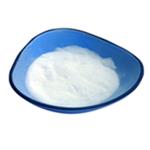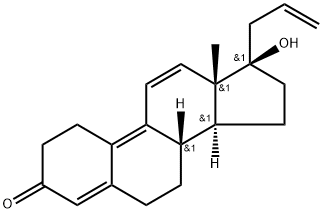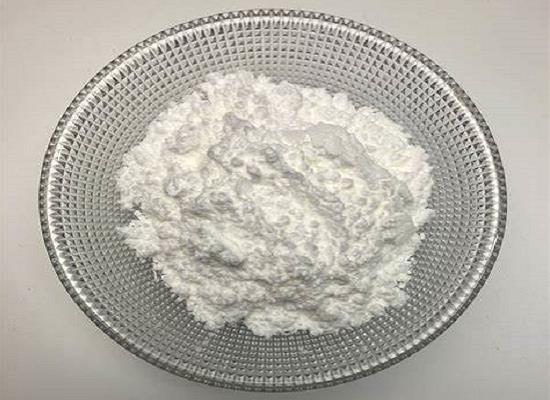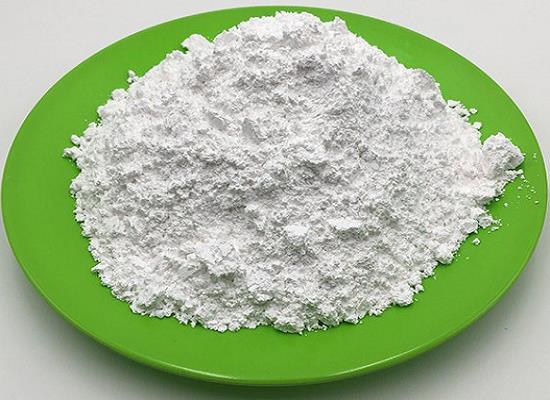Altrenogest: Overview, Effects on Reproductive Performance and Environmental Photochemistry
General Description
Altrenogest, a synthetic progestogen, is mainly used for estrous synchronization in gilts and primiparous sows. It suppresses ovarian follicular development, leading to precise synchronization of estrus. Studies show altrenogest can achieve high synchronization rates within 4 to 7 days. Research on its impact on reproductive performance has yielded varying results, with some studies indicating positive effects on litter size, while others suggest conflicting outcomes. Additionally, altrenogest undergoes rapid and efficient photolysis in the environment, forming photoproducts with potential androgenic activity. This poses environmental exposure risks, necessitating further research to assess contamination extent and potential ecological consequences.

Figure 1. Altrenogest
Overview
Altrenogest, also known as allyltrenbolone, is a synthetic progestogen primarily used for estrous synchronization in gilts and primiparous sows. It works by suppressing ovarian follicular development, leading to precise synchronization of the time of estrus. Studies have shown that altrenogest can achieve estrus synchronization rates of up to 93% within 4 to 7 days post-administration. While some research, such as that by Martinat-Botté et al, suggests that altrenogest treatment results in improved reproduction outcomes, including increased farrowing, estrous, and pregnancy rates, as well as larger litter sizes, other studies, like those by Fernandez et al and van Leeuwen et al, have not confirmed these benefits and have even indicated negative effects. The conflicting findings underscore the need for a systematic and quantitative assessment of existing studies to arrive at a comprehensive conclusion regarding the efficacy of altrenogest in enhancing reproductive performance in gilts and sows. 1
Effects on Reproductive Performance
Altrenogest's effects on the reproductive performance of primiparous sows have been studied extensively, revealing varying impacts on different reproductive variables. In primiparous sows, altrenogest treatment has shown a positive effect on the number born alive (NBA) and total number born (TNB), with significant increases observed (WMD = 0.67 for NBA, P < 0.001; WMD = 0.77 for TNB, P = 0.002). However, the treatment did not improve the efficiency of estrus detection within 10 days post-weaning (ER10) and led to a decrease in farrowing rate (FR) along with a non-significant decrease in pregnancy rate (PR). Further analysis was conducted to evaluate the impact of altrenogest treatment duration on these reproductive variables in primiparous sows. The results indicated that treatment for 6–8 days and more than 8 days showed positive effects on NBA and TNB, while treatment for 6–8 days had a negative effect on FR. Specifically, the >8 day treatment group exhibited significantly higher NBA and TNB scores compared to the 6–8 day group. Overall, these findings highlight the importance of considering both the duration of altrenogest treatment and its varying effects on different reproductive parameters in primiparous sows. 1
Environmental Photochemistry
Altrenogest, a synthetic progestin widely used in veterinary medicine, undergoes significant environmental photochemistry that affects its fate and persistence in the environment. Research has shown that altrenogest undergoes direct photolysis, which is the process of degradation by exposure to light, under environmentally relevant conditions. The photolysis of altrenogest is highly efficient and rapid, with a half-life of approximately 25 seconds. The rates of photolysis were found to be unaffected by changes in pH or temperature but were sensitive to oxygen concentrations. The primary photoproduct resulting from the photolysis was identified as an isomer formed through an internal 2 + 2 cycloaddition reaction. This primary photoproduct exhibits a triplet lifetime of 8.4 ± 0.2 μs and undergoes photohydration, forming photostable secondary photoproducts. These secondary photoproducts can undergo thermal dehydration in dark conditions, reverting back to the primary cycloaddition photoproduct over a time scale of hours to days. The rate of dehydration is accelerated at higher temperatures and both high and low pH values. Importantly, certain photoproducts retain significant androgenic activity, as demonstrated by in vitro androgen receptor-dependent gene transcriptional activation cell assays and in silico nuclear hormone receptor screening. These findings have implications for the environmental exposure risks associated with altrenogest and its photoproducts. The presence and cycling of altrenogest and its photoproducts in the environment can lead to prolonged androgenic activity, potentially impacting ecosystems and organisms exposed to them. Further research is needed to assess the extent of environmental contamination and the potential ecological consequences of altrenogest's environmental photochemistry. 2
Reference
1. Wang Z, Liu BS, Wang XY, Wei QH, Tian H, Wang LQ. Effects of altrenogest on reproductive performance of gilts and sows: A meta-analysis. Anim Reprod Sci. 2018;197:10-21.
2. Wammer KH, Anderson KC, Erickson PR, et al. Environmental Photochemistry of Altrenogest: Photoisomerization to a Bioactive Product with Increased Environmental Persistence via Reversible Photohydration [published correction appears in Environ Sci Technol. 2016 Sep 20;50(18):10292]. Environ Sci Technol. 2016;50(14):7480-7488.
Related articles And Qustion
Lastest Price from Altrenogest manufacturers

US $750.00/g2025-11-24
- CAS:
- Min. Order:
- 100g
- Purity:
- 99
- Supply Ability:
- 999

US $750.00-6500.00/G2025-07-04
- CAS:
- 850-52-2
- Min. Order:
- 100G
- Purity:
- 99
- Supply Ability:
- 9999




